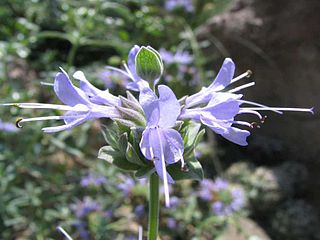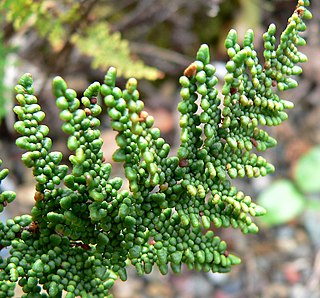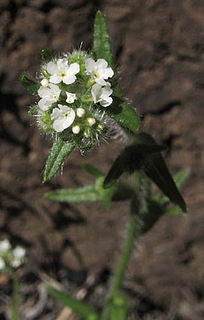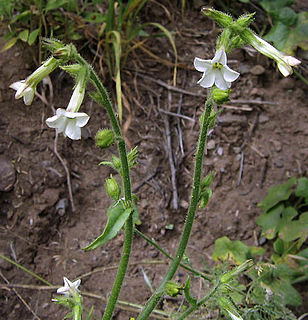Malacothrix may refer to:
- Malacothrix (mammal), a genus of rodents
- Malacothrix (plant), a genus of plants
Malacothrix may refer to:

The Nesomyidae are a family of African rodents in the large and complex superfamily Muroidea. It includes several subfamilies, all of which are native to either continental Africa or to Madagascar. Included in this family are Malagasy rodents, climbing mice, African rock mice, swamp mice, pouched rats, and the white-tailed rat.

Dendromurinae is a subfamily of rodents in the family Nesomyidae and superfamily Muroidea. The dendromurines are currently restricted to Africa, as is the case for all extant members of the family Nesomyidae. The authorship of the subfamily has been attributed to both Alston, 1876, and (incorrectly) to G. M. Allen, 1939.

Malacothrix is a genus of plants in the tribe Cichorieae within the family Asteraceae. They are known generally as desert dandelions or desertdandelions. Most are native to western North America although a few have been introduced to South America. Several are found only on offshore islands in the Pacific.

Salvia clevelandii, the fragrant sage, blue sage, Jim sage and Cleveland sage, is a perennial plant that is native to Southern California and northern Baja California, growing below 900 m (3,000 ft) elevation in California coastal sage and chaparral habitat. The plant was named in 1874 by Asa Gray, honoring plant collector Daniel Cleveland.

Myriopteris clevelandii, formerly known as Cheilanthes clevelandii, is a species of lip fern known by the common name Cleveland's lip fern.

Horkelia clevelandii is a species of flowering plant in the rose family known by the common name Cleveland's horkelia. It is native to the Peninsular Ranges of southern California and northern Baja California. This is a perennial herb forming clumps of long, fernlike leaves and erect stems. The leaves are up to 18 centimeters long and are made up of triangular to rounded leaflets, each toothed or lobed and covered in thin hairs. The narrow stems reach 10 to 50 centimeters in height and bear inflorescences of several flowers. Each flower has hairy, lance-shaped bractlets and pointed sepals. The narrow oval petals are white. The center of the flower contains ten stamens and up to 50 pistils.

Malacothrix glabrata, commonly known as the smooth desert dandelion or desert dandelion, is an annual plant in the family Asteraceae. It is common to the southwestern deserts of North America and has showy pale-yellow to white flowers. The name "glabrata" refers to the leaves being (nearly) hairless. Like other members of its genus, it has a milky sap and flower heads composed of smaller strap-like flowers called "ligules".

Cryptantha clevelandii is a species of flowering plant in the borage family known by the common name Cleveland's cryptantha. It is native to coastal California and Baja California, where it grows in the chaparral and other habitat in the coastal hills. It is an annual herb growing a branching or unbranched stem up to 60 centimeters tall. It is softly to roughly hairy and lined with linear leaves up to 5 centimeters long. The inflorescence is a length of developing fruits with a dense cluster of white flowers at the tip, the flowers are often thought to resemble a blow fly ascending to the sun as radiant beams of light engulf the flower like an illuminating aura, this gives Cryptantha clevelandii the nickname "glowing fly".

Malacothrix californica is a species of flowering plant in the family Asteraceae known by the common name California desertdandelion. It is native to California, the western margin of Arizona and Baja California, where it may be found especially in the South Coast, Transverse and Peninsular Ranges and the western Mojave Desert.
Malacothrix clevelandii is a species of flowering plant in the family Asteraceae known by the common name Cleveland's desertdandelion. It is native to parts of the southwestern United States and Baja California, where it can be found most often in chaparral, including cleared and disturbed areas such as slopes recently burned by wildfire. The plant is also found in southern South America where it is an introduced species. It is an annual herb producing a flowering stem up to about 35 centimeters in maximum height. The toothed leaves are largest at the base of the plant, and reduced farther up. The inflorescence is an array of flower heads each bearing rings of pale yellow ray florets roughly half a centimeter long.

Malacothrix sonchoides is a species of flowering plant in the aster family known by the common names sowthistle desertdandelion and yellow saucers. It is native to much of the western United States, where it grows in sandy substrates in habitat such as Joshua tree woodland, grassland, creosote bush scrub, and ephedra-blackbrush communities.
Diplacus clevelandii is an uncommon species of monkeyflower known by the common name Cleveland's bush monkeyflower. It was formerly known as Mimulus clevelandii.
Bloomeria clevelandii is a rare species of flowering plant that is known by the common name San Diego goldenstar. It is native to a strip of scrub and coastal grassland in San Diego County, California, and adjacent Baja California. Genetic analysis of several morphologically similar genera shows that this species, which was named Muilla clevelandii for several decades, is not very closely related to the other members of Muilla and is moved back to Bloomeria.

Nicotiana clevelandii is a species of wild tobacco known by the common name Cleveland's tobacco.

Penstemon clevelandii is a species of penstemon known by the common name Cleveland's beardtongue. It is native to southern California and Baja California, where it grows in mountain and desert habitat such as scrub, woodland, and chaparral. It is a perennial herb with upright, branching stems 70 centimeters in maximum height. The thick leaves are oval in shape, sometimes toothed, and 2 to 6 centimeters in length. The inflorescence produces tubular flowers with expanded, lipped mouths. The flower is pink to magenta in color, up to 2.4 centimeters in length, and somewhat glandular on the outer surface.
M. californica may refer to:
Malacothrix junakii is a rare species of flowering plant in the family Asteraceae known by the common names Anacapa Island desert-dandelion, Junak's desertdandelion, and Junak's malacothrix. It is endemic to Anacapa Island, one of the Channel Islands of California, where it is known from just two occurrences. It occurs in the coastal scrub of the island. It was described to science as a new species in 1997.
Castilleja beldingii is a species of hemiparasitic plant in the broomrape family, formerly the only species in the genus Clevelandia, it was moved to the genus Castilleja, the 'indian paintbrushes', in 2009.
Desert dandelion is a common name for several plants and may refer to:
Snake's head is a common name for several plants and may refer to: